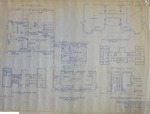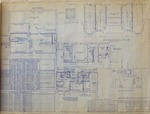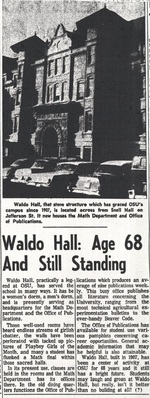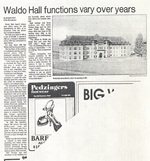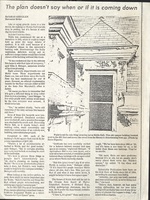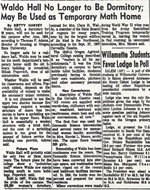Like any dwelling place, over the years Waldo Hall gradually fell into decline from usage and the elements. Building codes and safety requirements were changed from the time of its construction. Renovations to bring it to mid-Twentieth Century code would be costly, especially since OSU was facing similar problems with a number of its early buildings.
The 1963 feasibility study conducted by a firm from Portland, recommended tearing it down as the building was “sub-standard and obsolete”.[1] Because the building did not meet minimal safety standards for residential buildings, it stopped being used as a dormitory in 1965. A grandfather clause allowed its temporary use as offices, but only on the lower floors.
A mid-1970s campus planning study estimated that bringing the building into compliance with fire safety codes would cost more than erecting a new structure. Their recommendation was to tear down the building and use the open space to counter the new structure that was to be rebuilt in Agriculture Hall’s stead. Before Waldo Hall could be torn down, the state of Oregon’s legislature would have to okay it.[2]
The battle between cost and age continued. The university did an energy survey in the mid-1980s and found to their surprise that Waldo Hall was one of the most energy efficient buildings on campus. The method of measuring had been done via aerial equipment on loan from the U.S. Air Force and did not take into account that the top floor of the building was unoccupied with a thick layer of insulation laying on the floor tiles. This misinterpretation eased the talk of tearing the building down and replacing it with a modern structure.[3]
In 2008, the war between historians and modernists was over. The historians won. Part of the campus was designated as a historic district for the architectural importance it has for the state of Oregon. The 54 contributing buildings could not be torn down ever and must be maintained in their original appearance. Only the outsides of the buildings are considered historic, so the insides can be renovated and changed as the university sees fit.[4]
[1] Bear, McNeil, Schneider, Bloodworth & Hawes. Feasibility Study for Waldo Hall. Tech. Portland: n.p., 1963. Print.
[2] Abegglen, Sarah. "The Plan Doesn't Say When or If It Is Coming down." Daily Barometer [Oregon State University] n.d.: n. pag. Print.
[3] Brauner, David. Tour of Waldo Hall. Waldo Hall, Corvallis. 22 Feb. 2013. Lecture.
[4] "Oregon Historic Sites Database." Oregon Historic Sites Database. Oregon State Parks, n.d. Web. 30 Jan. 2013.

